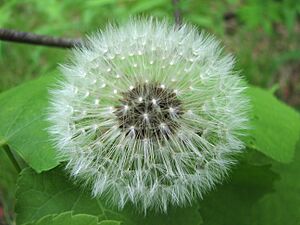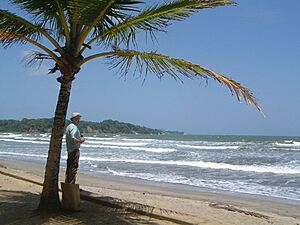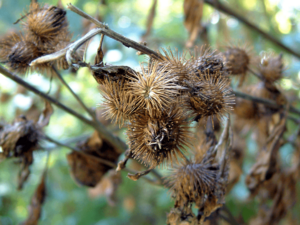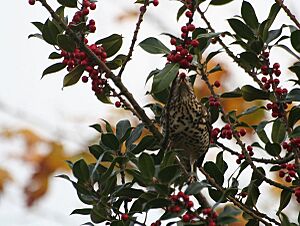Seed dispersal facts for kids
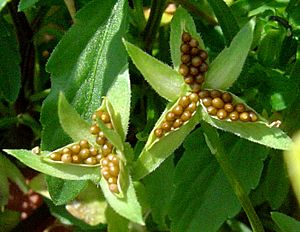
Seed dispersal is how seeds move away from their parent plant to a new place. Think of it like spreading or scattering. Plants can't move once they've grown roots, so it's super helpful for their seeds to travel. If seeds land too close to the parent plant, they'll all compete for the same sunlight, water, and nutrients. Spreading out also helps a plant species survive. If there's a problem in one area, like a flood or a fire, plants in other places can still thrive.
For millions of years, from the first land plants, most seeds and spores moved around using natural forces. Wind was the main way, and sometimes water helped too. A big change happened when flowering plants appeared. These plants developed amazing ways to work with animals, especially insects, for both pollination (moving pollen) and seed dispersal.
Seeds, and later the fruits that hold them, have special features that help them travel. Some are designed for wind or water, while others are perfect for hitching a ride with animals.
- Mechanical ways (using natural forces):
- Wind: Light seeds can float easily on the wind. Some are even blown out with force.
- Explosive action: Some plants shoot their seeds out!
- Water: Seeds and fruits that can float are carried by water.
- Animal ways (using living creatures):
Contents
How Seeds Travel
Wind Power: Flying Seeds
For a seed to travel by wind, it needs to be very light. It must be able to float easily, or it will just fall to the ground. Some seeds, like those from milkweed and dandelions, have tiny "parachutes" that help them fly.
Other seeds are super small and light, almost like dust. Orchid and poppy seeds are good examples. Poppy seeds grow inside a small capsule with tiny openings at the top. On a windy day, the poppy fruit sways, shaking out the tiny seeds like a salt shaker.
Another type of fruit that travels by wind is the maple tree fruit. These are called samaras and look like two-sided wings. Their lightness and "wings" help them spin through the air until they land in a new place with good soil. Elm and birch trees also have samaras.
Explosive Action: Seeds That Pop!
Some fruits can actually fling their seeds away when they are ripe. This is like a tiny "machine" throwing the seeds!
Pea pods often use this method. When the seeds are ready, the pod dries out. The inside of the pod dries faster than the outside, which makes the pod twist. It suddenly splits open violently, curling into a little spiral. This action makes the seeds fly out in all directions.
Impatiens plants, also known as "touch-me-nots," are famous for this. When their seeds are ripe, the dried fruit becomes a trigger. If an animal or human touches the plant, it bursts open and sprays the seeds everywhere. If the ground is wet, the seeds can germinate right where they land. They can also stick to the creature that touched them, helping them travel even further.
Violets and gorses also use explosive dispersal. When their seeds are ready, the fruit opens with a loud "POP!" sound. The squirting cucumber is another fruit that uses this method. Many other fruits use this amazing way to spread their seeds.
Water Travel: Floating Seeds
Plants that use water for dispersal usually grow near water. Once a seed falls into the water, it can be carried a long distance before it finds a place to grow.
The water lily is a great example. Its beautiful flowers produce a fruit that floats in the water for a while. Then, it sinks to the bottom to take root on the floor of a pond. Water lily seeds can grow right there in the water.
Palm trees, which often grow near the ocean, also use water to spread their seeds. Powerful ocean currents can carry coconuts, which are the palm tree's seeds, across vast distances to new homes.
The mangrove tree lives right in the water. Their seeds fall from the tree and start to grow roots as soon as they touch soil. If there's a lot of water, they can be carried far away before rooting.
Most nuts, like acorns, walnuts, and pecans, can be dispersed by both water and animals. They often travel by water during floods or if their plants grow near a river or stream. Many nut trees grow in areas that flood often. While water is important for nut trees, it's not as crucial as it is for some other plants, because many nut trees have roots that can grow far to find good soil and water.
Animal Helpers: Seeds on the Move
Animals help spread seeds in several ways. One common way is when seeds stick to them. Think of burrs that cling to your socks or pants when you walk through grassy fields. The parent plant makes these spiky burrs from its flower. These burrs either fall off the plant onto the ground, or they wait for a passing animal (or person) to pick them up on their fur, feathers, or socks.
The burr then travels to a new place. Animals usually try to get the burrs off themselves by scratching or pecking at them. The burr then drops to the ground, far from the parent plant. Many grass seeds have surfaces that easily catch onto passing creatures. For example, spear grass has spiky tips that can get stuck in animals or be blown by strong winds to a new spot.
Another way animals help is by actually planting the seeds. Animals like mice, squirrels, and jay birds collect fruits and nuts in the spring and summer. They store these for the coming winter. Often, they save these fruits and nuts by burying them in the ground. They usually bury more than they need. When they come back to get their food, they leave a few buried. These forgotten seeds then grow into new plants.
Seeds are also often spread through animal droppings (poo). Animals swallow fruits whole, including the seeds. They digest the soft fruit, but the seeds pass through their system and come out in their droppings. In some rainforests, almost 90% of tree species are spread by animals. Animals like bats – for instance, the short-tailed fruit bat in South America – can scatter up to 60,000 seeds in just one night!
Images for kids
-
Wind dispersal of dandelion fruits
See also
 In Spanish: Dispersión de los propágulos para niños
In Spanish: Dispersión de los propágulos para niños


